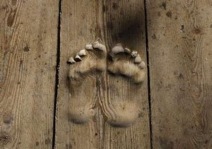Ora Pro Nobis
Thursday, March 05, 2009

Footprints carved in wood, which locals believe were made by a worshipper who prayed at the same spot for decades, are seen at a monastery near Tongren, Qinghai province February 5, 2009. Local Tibetan monks and pilgrims gather to celebrate Monlam, or Great Prayer Festival, one of the most important festivals in Tibetan Buddhism.
Prayer is not something we hear much about in the Craft. We in the Pagan community can get a bit touchy about prayer. In my tradition, we often state that we do not, technically, “worship” in our rituals; rather, we commune. We use ritual to unite with our Gods. Another way of saying it, is that we use ritual to access the Gods within us. To go inside most of all. We do not worship because the Gods are in all life, including in us. Therefore, to worship, or to pray, would be to suggest separation.
While I hold this view, I still think that prayer is underrated in the Pagan community. Why? Because prayer is more than an act of supplication or submission. It is more than simply asking for something or demanding help. In its highest expression, prayer is a posture, an attitude and energy. Prayer is not necessarily about “giving up” personal responsibility. Instead, we can think about it as “giving over” yourself to a greater connection: to the Earth, to life, to Spirit. It can be about seeing yourself as “part of” as opposed to “center of.” This implies humility and not allowing the ego to take hold, which is, in my view, the opposite of separation.
In addition, prayer can be seen as a means of participating in the eternity of the Divine. This is because it is a conversation--one that never ends. It is an ongoing conversation about love and oneness. Our Gods love to talk to us. They love to hear from us and when we talk to them, they show up. If we don’t, they don’t judge, but they’re always available and they won’t stop talking just because we don’t. That is the nature of unyielding connection and love, of the continuity and endlessness of life and Spirit. This image of footprints communicates all that for me: humility and continuity.
For this reason, I find this image of footprints so compelling. A student of mine who is an ex-Catholic nun sent it to me and stated that it reminded her of when she was a nun standing in the choir of a 16th century monastic abbey. The floor boards were worn from years and years of wear where the nuns one by one had taken their place. The experience of standing in their place and footprints made the sense of on-going prayer a reality. There she stood where those before her had stood for hundreds of years, humbly praying the same prayers and keeping the cycle of prayer going.
Ritual can be prayer in this sense. We go into ritual humble because we are opening ourselves to the learning and to greater connection. We are continuing the cycle because by stepping into circle on a Sabbat or a Moon, we are doing what our ancestors have done for eons: connect with Nature, with Spirit, with Life and with the Gods.
Bright Blessings,

